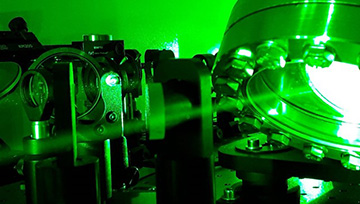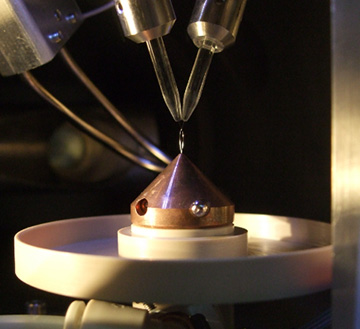![]()
Caterina Vozzi
This year saw the launch of an ambitious new pan-European program to push the envelope on tabletop ultrafast X-ray spectroscopy. The Horizon 2020–funded Innovative Training Network on the Study of carrier transport in MAterials by time-Resolved specTroscopy with ultrashort soft X-ray light—which goes by the much more manageable nickname SMART-X—aims to create a collaborative training network, including 15 early-career researchers, that will drive the technique beyond the current state of the art in material science.
OPN spoke with OSA senior member Caterina Vozzi, IFN-CNR, Italy, who’s at the helm of the SMART-X network, to learn more about the project and what it could mean for European spectroscopy.
What are the goals of the SMART-X project?
The SMART-X project is all about the development of ultrafast X-ray spectroscopy. But first and foremost, this is a training network. The EU is giving us money through Horizon 2020 for recruiting and training 15 Ph.D. students in what it believes will be an excellent, high-level research environment. So the focus is on training those researchers—both in science and soft skills.
Scientifically, there are three main objectives: better understanding of light-harvesting materials; understanding of topological properties of low-dimensional materials; and, of course, the development of ultrafast X-ray spectroscopy itself.
Most of the activities will be performed by these Ph.D. students in collaboration with PIs and researchers in the participating institutions. These students will be trained to perform and understand these experiments and to develop the experimental and theoretical approaches.
What makes ultrafast X-ray spectroscopy so interesting?

A detail of a Ti:Sapphire laser amplifier—a standard source for driving ultrafast spectroscopy experiments. [Image: SMART-X]
This is a technique that has been used for some proof-of-concept experiments, but it is not very well established. You can have extreme temporal resolution with this technique, which means that you can really look at the electron dynamics for materials. Sometimes, you want to use a material for a device, but you don't really know the relationship between the chemistry of the material and how the charge moves.
For instance, perovskites are a very efficient light-harvesting material, more so than silicon, but there are two major problems. On the one hand, they contain some pollutants like lead. On the other hand, we don’t know in detail why they are efficient in absorbing light and then transferring some charge. This is true for many new materials that we would like to understand, including 2D topological materials.
We need more insight to be able to exploit such materials properly in an application. And ultrafast X-ray spectroscopy can help to do this, because it simultaneously provides extreme temporal resolution and chemical sensitivity.
What inspired you to propose this project?
I've been working in attosecond science and in ultrafast spectroscopy of atoms and molecules for quite a long time now. But recently, we started getting involved doing experiments on solids, new materials, and it was really engaging. I realized that there are so many applications for this technique as we start moving toward targeting more complex systems and trying to understand dynamics in a solid environment.
I discussed the idea while at an event in Brussels for another innovative training network in 2018 and began talking with Prof. Marc Vrakking from the Max Born Institute about developing a program and creating a network of people to work on this.
We started from there, and now I'm very enthusiastic about how far we’ve come. Although we are only in the recruitment phase, we are already discussing doing experiments together. We have people from theory that want to develop tools for interpreting results and people from large-scale facilities that are involved—such as the Synchrotron SOLEIL and the FERMI Free Electron Laser facilities—so we can plan collective experiments. We also have people doing samples, because growing samples for these specific, exotic materials is not simple.
For a network like this, it's also very beneficial to have high-tech companies involved, so we have a laser company, Fastlite, and then we have a company working on X-ray CCDs, Greateyes.
That sounds very collaborative across academia and industry, multiple scientific disciplines, and multiple countries.

Liquid jet for experiments in vacuum. With this special target it is possible to study samples in liquid phase by XUV ultrafast spectroscopy. [Image: SMART-X]
From an international perspective, the spectroscopy community in Europe already collaborates quite a lot, and I think it’s a really good environment. These kinds of innovative training networks within the Horizon program really facilitate that for different topics.
This study is at the boundary of chemistry and physics. There's a lot of physics involved just for the generation of the ultrafast X-ray pulses, and then you also need to study the complex samples from the point of view of material science and chemistry. We’re putting all of that together and creating a network because you need to have all of this expertise that would be difficult to find in one place.
In the SMART-X network, each Ph.D. student will have at least six months of secondment, where he or she travels to different institutions in Europe for training and participates in these collaborations. For example, the students coming to my lab will learn about ultrafast lasers, but we want them to also learn about the sample growing and the theory. They will also receive training from a company in the network so they can understand how R&D is done in industry.
What is the timeline of the program, and has it been impacted by the pandemic?
The project lasts for four years, but the position for the Ph.D. is three years. The project began in March 2020, but with the pandemic, it’s a complicated time. Luckily, EU-funded projects will be extended.
Now we’re in the middle of the recruitment phase, and hopefully by the beginning of next year, we will have every piece in place. We expect to have scientifically important results within probably the last year of the project, when we will have developed the technique, established new collaborations and performed experiments.
As a partner, what role will OSA play in SMART-X?
I had the idea of involving OSA because OSA’s support throughout my scientific career has always been so useful to me. I’ve been chairing an OSA Technical Group for a few years, and that made me realize the many other things that you can do through OSA beyond mentorship and things like that.
I thought that OSA could give SMART-X really useful advice for the training part of the program, and that we could also combine our efforts and create open events—such as webinars—that might involve OSA Technical Groups and the wider OSA community.
What is the one thing that you most want this program to achieve?
This is important as a research project. The most important thing is to train these people to be leading scientists of tomorrow. I really feel that this is an opportunity to leave a footprint and contribute to the community—much more than just a paper.
